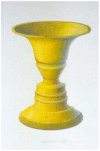Why Does Rubin's Vase Differ Radically From Optical Illusions? Framing Effects Contra Cognitive Illusions
- PMID: 34621202
- PMCID: PMC8490627
- DOI: 10.3389/fpsyg.2021.597758
Why Does Rubin's Vase Differ Radically From Optical Illusions? Framing Effects Contra Cognitive Illusions
Abstract
Many researchers use the term "context" loosely to denote diverse kinds of reference points. The issue is not about terminology but rather about the common conflation of one kind of reference points, such as rules of perception, which is responsible for optical illusions, with another kind, known as "context" or "frame," as exemplified in Rubin's vase. Many researchers regard Rubin's vase as a special kind of optical illusions. This paper rather argues that the two phenomena are radically different. Optical illusions are occasional mistakes that people quickly recognize and eagerly correct, while the different figures of Rubin's vase are not mistakes but, rather, the outcomes of different perspectives that do not need correction. The competing figures in Rubin's vase can, at best, in light of more information, be more warranted or unwarranted. This paper discusses at length one ramification of the proposed distinction. The framing effects, such as loss/gain frame, are the products of contexts and, hence, resemble greatly the figures in Rubin's vase. In contrast, cognitive illusions generated occasionally by the rules of thumb (heuristics) are mistakes and, hence, resemble optical illusions. The proposed distinction carries other ramifications regarding, e.g., happiness studies, moral judgments, and the new philosophy of science.
Keywords: Kuhn's paradigm; behavioral decision sciences; behavioral economics; perspective; prospect theory; reference points; reference-as-context; reference-as-heuristic.
Copyright © 2021 Khalil.
Conflict of interest statement
The author declares that the research was conducted in the absence of any commercial or financial relationships that could be construed as a potential conflict of interest.
Figures





References
-
- Adelson E. H. (2000). Lightness perception and lightness illusions, in The New Cognitive Neurosciences, ed Gazzaniga M. (Cambridge, MA: MIT Press; ), 339–351.
-
- Ajzen I. (1977). Intuitive theories of events and the effects of base-rate information on prediction. J. Pers. Soc. Psychol. 35, 303–314. 10.1037/0022-3514.35.5.303 - DOI
-
- Berkeley G. (2009). Principles of Human Knowledge and Three Dialogues, ed Robinson H. Oxford: Oxford University Press.
-
- Bool F. H., Kist J. R., Locher J. L., Wierda F. (1982). Mc Escher: His Life and Complete Graphic Work. New York, NY: Harry N. Abrams. Inc.
Publication types
LinkOut - more resources
Full Text Sources

